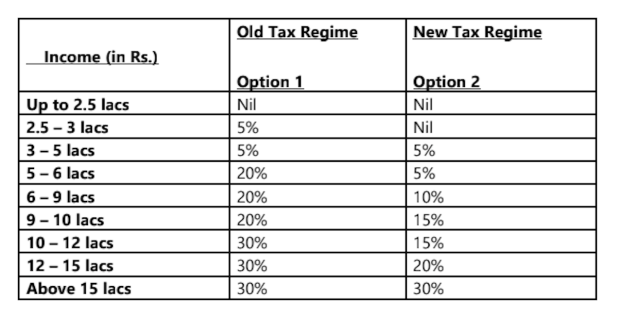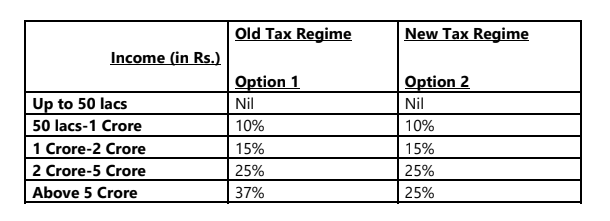How to choose tax regime for FY 2023-24: Selecting the best option between old and new tax regimes is proving difficult for many salaried taxpayers, especially for those who are in the higher income bracket and making various tax-saving investments. However, it is the time of the year when every salaried employee has to intimate his/her employer about the tax regime option, failing which the employer will deduct TDS from salary as per the new regime rates sans various deductions and exemptions available under the old regime. That said, the following will help you select the best tax regime for maximum tax savings.
The first step for deciding on the tax regime is to compare both regimes. Under the old regime, a salaried taxpayer can claim several deductions, exemptions, and allowances for tax savings. It allows employees to follow different strategies to lower their tax obligations.
The exemptions available under the old regime include House Rent Allowance (HRA) and Leave Travel Allowance (LTA). When it comes to deductions, Section 80C is the most popular option that allows taxpayers to reduce their taxable income by up to Rs.1.5 lakh. Under the old regime, the tax rebate under Section 87A is available up to income of Rs 5 lakh. This goes up to Rs 7 lakh under the new regime.ITR filing due date for AY 2021-22 extended! Check new deadline to file income tax return
“There are a few factors that one should keep in mind before selecting a tax regime. The person should check his total income. He should also evaluate the quantum of tax savings investment made by him. Further, HRA benefits availability and carry forward losses are also two major factors that one should consider before selecting the tax regime. For industrialists especially, there is no concept of additional depreciation in the new regime, so a tax regime has to be chosen accordingly,” says Atul sharma, Founder, Lex N Tax.
Dr Suresh Surana, Founder at RSM India says, “Both the old tax regime and the new tax regime u/s 115BAC of IT Act have their own benefits and drawbacks. The decision of the taxpayer to choose between such tax regimes would generally depend upon a number of factors such as investment goals/ objectives, income levels, applicable tax rates, exemptions and deductions available etc. Hence, a detailed comparative evaluation and assessment under both tax regime shall be made before making a decision regarding the same.”
Also Read: New Tax Regime Calculator 2023-24: How much tax you will have to pay on Rs 9 to Rs 15 lakh income
Dr Surana suggests the following points that taxpayers should consider to decide on the best tax regime for themselves:
- Salaried individual taxpayers with total income of upto Rs. 7,50,000 may opt for the new tax regime u/s 115BAC of the IT Act and claim the benefit of standard deduction u/s 16(ia) of IT Act up to Rs. 50,000. Further, the effective tax rate would be nil on account of claiming of rebate u/s 87A of the IT Act.
- Taxpayers intending to claim deduction under Chapter VI-A or exemptions, leave travel concession, house rent allowance, housing loan repayment, etc. may prefer the old tax regime over the new tax regime.
- Further, since the surcharge rates have been reduced from 37% to 25% for total income exceeding Rs. 5 crores, it brings down the effective tax rate from 42.744% to 39%.
Use Income Tax Calculator to decide
Another way to decide between the old and new regimes is to do a calculation. The following Income Tax calculator will help you:
List of Deductions and Exemptions under Old Tax Regime
- Investments under Section 80C up to Rs 1.5 lakh (Public Provident Fund, Equity Linked Savings Scheme (ELSS), Employee Provident Fund, Life Insurance Premium, Home Loan Principal etc).
- Home Loan Interest Payment (up to Rs 2 lakh)
- Children Education and Hostel Allowance
- Helper Allowance
- Health Insurance Premiums – Rs 25,000 for Self, Spouse and Children and another Rs 25,000 for parents (Rs.50,000 for senior citizens)
- Expenses on medical treatment, training or rehabilitation of a
- disabled dependent: Rs.75000 (Rs.125000 for the person with severe disability )
- Treatment of self or dependent for specified disease: Rs 40,000
- (Rs.1,00,000/- for senior citizens)
- Employee’s contribution to NPS up to Rs 50,000
- Interest on Education Loan
- Donation to specified institutions
- Saving Bank Account Interest up to rs 10,000 under Section 80TTA
- Disability of self: Rs.75,000 to Rs.1,25,000 depending on disability
- House Rent Allowance
- Leave Travel Allowance
- Mobile and Internet Reimbursement
- Food Coupons or Vouchers
- Company Leased Car
- Standard Deduction
- Uniform and Washing Allowance
- Leave Encashment
By carefully investing in tax-saving instruments and claiming exemptions, a salaried employee can successfully reduce his/her tax liability by lakhs under the old regime.
However, except for standard deduction, none of the above tax saving benefits is available under New Tax Regime for FY 2023-24. Though the new regime is simple, the low tax rates under this regime can be availed only if the employee wants to give up on various deductions and exemptions available under the old regime. This means, if an employee opts for the new regime s/he will have to give up important exemptions such as LTA, HRA, and various deductions under Section 80C, D0D, 80E, 80G including interest payment on home loan under Section 24 (b).
Also Read: Tax Regime Selection: New vs Old? 5 reasons to decide now
Tax Rates in New and Old Regimes
 Old vs New Regime Tax Slabs and Rates Old vs New Regime Tax Slabs and Rates
Surcharges in New and Old Tax Regimes
 Surcharged under Old and New Tax Regimes. Health and Education Cess is 4% of Income tax and Surcharge in both Surcharged under Old and New Tax Regimes. Health and Education Cess is 4% of Income tax and Surcharge in both
regimes
In the end, it can be said that both tax regimes have their own benefits and drawbacks. If you are investing in various tax-saving instruments and making spends that qualify for exemptions, you can opt for the old regime if the calculation shows you can save more. If not, you should opt for the New Regime as it is simple and you don’t have to worry about investing/spending for tax savings.
|